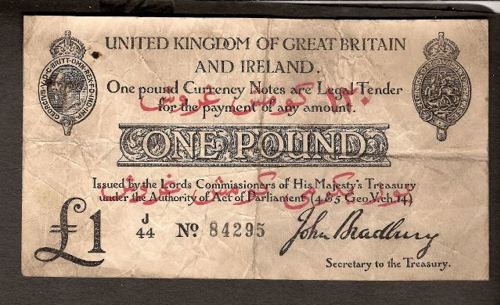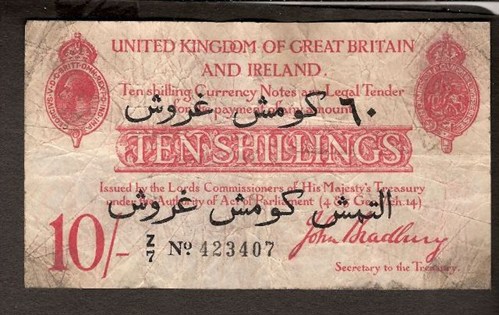The Bradbury Note
Up until the First World War, gold sovereigns and half sovereigns had circulated as everyday currency for about a hundred years, so it was not until the 1833 Bank Charter Act, when 'Bank of England' notes became legal tender in England and Wales. Did you know that the Dardanelles Campaign gave rise to a special kind of note, or actually two notes?

On 5th August 1914 (the day after the First World War was declared), the Currency and Bank Notes Act was passed. This allowed the Treasury to issue currency notes of £1 and 10/-. These notes had full legal tender status and were convertible for gold through the Bank of England.
BRADBURY - The first notes were produced to a hurried design and, because of the lack of availability of banknote paper, were printed on paper produced for postage stamps. The £1 note was issued on Friday August 7th and the 10/- a week later. These are known as the first Bradbury issue after the Permanent Secretary to the Treasury, Sir John Bradbury. John Bradbury was born in 1872 and entered the Civil Service in 1896, first in the Colonial Office and then the Treasury. After serving under Asquith and then Lloyd George, Bradbury was appointed one of two permanent secretaries to the Treasury in 1913. Bradbury remained the governments chief financial advisor during the war and left the treasury on 27 August 1919 to become principal British delegate to the Reparation Commission. Within days a new design was being worked on. The design was produced by Mr. George Eve and the notes were printed on banknote paper. The notes were issued on 23rd October (£1) and 21st January 1915 (10/-).
Within days a new design was being worked on. The design was produced by Mr. George Eve and the notes were printed on banknote paper. The notes were issued on 23rd October (£1) and 21st January 1915 (10/-).
Some of these notes were overprinted in Arabic, by the Treasury, for use by the British forces in the Mediterranean Expeditionary Force (MEF) out in the Dardanelles and Gallipoli. These were emergency issue, uniface and were overprinted in Arabic script for the Dardanelles campaign. Apparently they were issued for use for the entire British MEF in the Mediterranean and the Naval fleet.
The Arabic text translates as “Piastres Silver 120” in the top line and “Piastres Silver One Hundred and Twenty” in the lower line.
